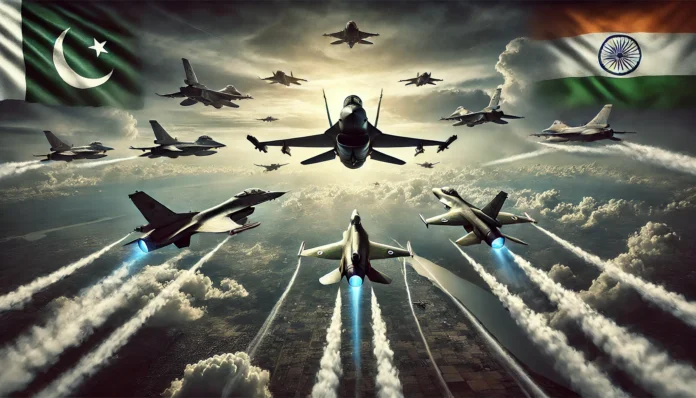Owing to the enduring rivalry between the two nuclear-armed states; India and Pakistan, strategic stability in South Asia continues to remain precarious and fragile. The adversarial relations between the two states have resulted in three conventional wars, one limited conflict, multiple crises, and a number of border skirmishes.
The 2019 Pulwama-Balakot episode, was one such crisis – a key moment in South Asia’s strategic landscape – which continues to offer critical insights into the region’s deterrence dynamics and the risks of conflict escalation. Beyond its immediate strategic, diplomatic and political implications, the crisis also delineated how India’s aggressive nationalist rhetoric and political opportunism – in the time of a crisis – held the potential to push the two nuclear-armed nations toward a full-scale conflict.
During the Pulwama-Balakot crisis, while Pakistan displayed strategic restraint and diplomatic prudence, on the other side of the border, India – led by Prime Minister Modi – allowed itself to be driven by electoral considerations, and capitalized the standoff to fuel nationalist sentiments and to bolster political support; displaying its propensity to priorities political considerations over national security and strategic stability imperatives.
The crisis began after a suicide attack targeted a convoy of the Central Reserve Police Force (CRPF) in Pulwama district, Indian Illegally Occupied Jammu and Kashmir (IIOJ&K) on February 14, 2019; killing 40 paramilitary personnel. The attack took place at a time when India was undergoing an election campaign for India’s general elections, in which the incumbent Prime Minister Narendra Modi was seeking a re-election.
This rendered political stakes for the Bharatiya Janata Party (BJP) high and the party resorted to galvanizing the incident to fan anti-Pakistan and ultra-nationalist sentiment among the Indian public. In the days that followed, India and Pakistan exchanged heavy artillery fires along the Line of Control, with New Delhi suspending a number of travel and trade-related confidence-building measures. Within two weeks, the crisis escalated into a military standoff.
The Modi government authorized the Indian Air Force (IAF) to conduct an unprecedented aerial strike inside Pakistan’s territory. On February 26, 2019, the IAF crossed the Line of Control (LoC) in an attempt to launch an airstrike. However, the Indian jets were intercepted by the PAF, forcing them to retreat. In the process, the Indian aircrafts released their payload, with the bombs landing in an open area in Balakot, Khyber Pakhtunkhwa province. However, on the contrary, the Indian Foreign Secretary Vijay Gokhale asserted that the attack had inflicted heavy casualties on militants.
However, Islamabad refuted these claims. An independent satellite imagery analysis by the reputable UK-based news agency Reuters also contradicted India’s narrative. The agency published a detailed analysis showing no significant structural or personnel damage at the purported site. Despite the lack of credible evidence, the Indian media amplified these exaggerated claims, fuelling a nationalistic fervor that allowed the Indian government to sustain its confrontational posture.
In response, Pakistan responded by launching the Operation Swift Retort on February 27, launching a decisive and proportionate retaliatory airstrike in the Nowshera-Rajouri sector of IIOJ&K. Unlike India, Pakistan deliberately avoided populated areas, underscoring its commitment to responsible military conduct while simultaneously restoring deterrence.
In a significant display of air superiority, the Pakistan Air Force (PAF) shot down two Indian fighter jets. In the process, an IAF Wing Commander was also captured alive; however, in a calculated diplomatic manoeuvre, he was returned to India as a goodwill gesture; exposing India’s reckless adventurism whilst preventing any further escalation.
During the crisis – amid heightened fears of conflict escalation Pakistan repeatedly called for a diplomatic resolution through multiple press conferences. On the other hand, the Indian government refrained from making any formal press appearances thereby curtailing transparency, whereas sensitive information only came through leaks from unnamed government officials. Instead, BJP leaders resorted to aggressive rhetoric, which significantly shaped BJP’s 2019 election campaign.
PM Modi made a number of several provocative statements which aimed at stirring nationalist sentiment. The fusion of military action with electoral politics became even more apparent in Modi’s speeches following the strikes. For instance, Modi was recorded glorifying the escalation, referring to a potential follow-up operation to the Operation Swift Retort as ‘Qatal Ki Raat’ (Night of Slaughter).
His provocative rhetoric was evident in his bold claims about the Balakot airstrikes which he claimed, aimed at killing 300-400 Pakistanis. These remarks reinforced the BJP’s hardline national security stance and anti-Pakistan narrative, bolstering Modi’s strong-leader image ahead of the elections. A few days after the Operation Swift Retort, while addressing an election rally, Modi claimed; “Hum Ghar mein ghus ke maarenge” (We will enter their home and kill them), portraying the strikes as a decisive military success.
In another incident, While alluding to Indian airstrikes in Balakot, he flouted them as merely a “pilot project,” hinting at a larger military operation. In yet another election rally in the state of Maharashtra, Modi asked voters to dedicate their vote to those who carried out the air strike in Balakot.
This pattern of political opportunism extended beyond Modi himself. At an election rally in Uttar Pradesh, BJP’s president Amit Shah, declared that only Modi and the BJP could deliver a “fitting reply” to Pakistan and “wipe out terrorism,” reinforcing the party’s militarized nationalist rhetoric. Another senior BJP leader and former chief minister of the state of Karnataka was recorded of saying that the air raids will help the party win 22 seats in the state. The electoral motivations behind the BJP’s crisis narrative were further exposed in 2023 when the former IIOJ&K governor Satya Pal Malik revealed in an interview that the BJP government suppressed details of the Pulwama attack to blame Pakistan and to fuel nationalist fervor for electoral gains. He held the Indian Home Ministry’s incompetence responsible and claimed that when he raised concerns with Modi and National Security Advisor Ajit Doval, he was told to remain silent.
The crisis therefore highlighted key troubling aspects of India’s political leadership. As Modi capitalized on the crisis to galvanize electoral popularity, it revealed how electoral considerations can supersede national security considerations in New Delhi’s calculus.
While BJP’s war-mongering rhetoric was instrumental in heightening tensions, the Indian media on the other hand, also amplified the government’s narrative, thereby playing a key role in disseminating exaggerated news – particularly pertaining to casualty figures and unfounded claims of operational success.
This also indicates the significance of fact-based reporting and responsible journalism for curbing misinformation and for preventing crises from escalating unnecessarily. Lastly and most importantly, the crisis unveiled how India’s aggressive military signalling can increase the risk of inadvertent escalation in a nuclear-armed environment.
This is manifest from the fact that at the height of the crisis, India reportedly threatened to launch six missile strikes against Pakistan. In addition to this, the Pakistan Navy also detected an Indian submarine within Pakistan’s maritime zone, which was then stopped from entering Pakistan’s territorial waters. Days later, the Indian Navy also claimed that during the crisis, its major combat units, nuclear submarines, and aircrafts were operationally deployed.
To conclude, the Pulwama – Balakot crisis was a critical moment in South Asia’s strategic stability, exposing the dangers of war-mongering leadership, the perils of military brinkmanship, and information warfare in crisis escalation. While the crisis did not escalate into a full-scale war, it underscored the necessity of understanding the primacy of strategic restraint and level headedness in crisis situations, as well as crisis management mechanisms.
As tensions between India and Pakistan persist, maintaining crisis stability hinges upon communication and diplomatic channels, but most importantly, on firm commitment to responsible statesmanship and politico-military prudence and restraint


[…] Publication Link: https://thegsinsight.com/prudence-versus-opportunism-reminiscing-the-2019-pulwama-balakot-crisis/ […]
Comments are closed.